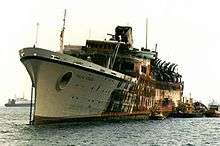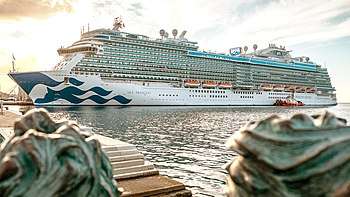SS Flandre (1951)
Flandre, also known as Carla C, Carla Costa, and Pallas Athena, was an ocean liner and cruise ship that took passengers on transatlantic voyages and on Caribbean and Mediterranean cruises from 1952 to 1994. She was operated by the French Line, Costa Cruises, and the Epirotiki Line.
 Former SS Flandre in service as Pallas Athena | |
| History | |
|---|---|
| Name: |
|
| Operator: |
|
| Port of registry: | |
| Builder: | Ateliers et Chantiers de France |
| Yard number: | 206[1] |
| Launched: | 31 October 1951[1] |
| Maiden voyage: | 23 July 1952[1] |
| Identification: | IMO number: 5116098 |
| Fate: | Destroyed by fire 23 March 1994 |
| General characteristics | |
| Tonnage: | 20,469 GRT[2] |
| Length: | 599.7 ft (182.8 m)[2] |
| Beam: | 80.3 ft (24.5 m)[2] |
| Installed power: |
|
| Propulsion: | Two propellers[2] |
| Speed: | 22 knots (41 km/h; 25 mph)[2] |
History
French Line

Flandre was the French Line's first new ocean liner following World War II. Her maiden voyage was considered a complete disaster, as she experienced mechanical difficulties throughout the voyage. The first sign of trouble was when her fuel line filters became clogged with impurities in the oil that she was carrying. This caused her to become essentially "dead in the water" for four hours while her fuel filters were cleaned out and her boilers restored to normal operation. This was repeated later in the voyage, after which Flandre's captain elected to reduce speed for the remainder of the voyage. Upon arrival at the Quarantine Station at New York, she experienced a short circuit in her main electrical switchboard causing a near-complete loss of power. Nearly three hours later, she had sufficient power restored to raise the port anchor. An additional three hours were required to raise the starboard anchor to allow her to continue.
Unlike most ocean liners' maiden arrivals, where they receive the traditional fireboat welcome while sailing under their own power, Flandre arrived in New York Harbor and received the traditional welcome while under tow by four Moran tugs, while also running one propeller of her own. Her funnel put out thick clouds of smoke, seeming to almost be straining as it was doing so. She was initially blowing her whistle as she arrived under tow, but after the whistle failed due to her limited power, the ship's siren was substituted. This lacklustre arrival garnered her the nickname "Flounder" by Manhattan dockers.[3]
Flandre's return voyage was delayed to allow engineers to repair her engines. Following her return to France, all of her 1952 sailings were cancelled, and she returned to her builders for thorough repairs. Repairs would take six months, and she returned for the 1953 sailing season.
During her French Line career, her passenger configuration changed several times, with Flandre running on the transatlantic route for nine months out of the year, and three months cruising with her near-sister SS Antilles. In 1967, she was withdrawn completely, and was sold to the Italian firm Costa Cruises, who renamed her Carla C.
Costa Cruises
The first assignment for the newly refitted Carla C was a charter for Princess Cruises, which marketed her as "Princess Carla" (the ship was not renamed). It was during this time that a set of producers originated the idea of the popular television-series The Love Boat aboard Carla C. Consequently, the first scripts were written on board the ship.
The ship proved problematic at first, after problems were detected with the boilers. In 1974 and 1975, Costa replaced the boilers with Stork-Werkspor diesel engines and Carla C was returned to service around the Caribbean, where she served until 1992. In 1984, the ship underwent another major refit, to ensure safe travel for its passengers for many years to come. In 1986, Carla C was renamed Carla Costa. No other changes occurred with the name change.
Carla Costa was a common sight on the San Juan ship dock on Saturdays during that era, and her regularly scheduled route included Curaçao, Caracas, Grenada, Martinique, and St. Thomas USVI.
Epirotiki Line

In 1992, Carla Costa was sold to the Greek Epirotiki Line, and renamed Pallas Athena, after the Greek goddess Pallas Athene. For the Epirotiki Line, she ran seven-day cruises from Athens to the Aegean Islands and Turkey. On 23 March 1994, Pallas Athena was destroyed by fire, which caused the superstructure and funnel to cave in on themselves. She arrived at the Aliaga Company scrapyards on 25 December 1994, one of only two surviving French Line ocean liners.
In popular culture
Flandre or Antilles appeared as stock footage in the 1964 Perry Mason episode Nautical Knot, set near Acapulco, Mexico. The scenes on board were filmed on a studio set. P&O Line's equally popular SS Arcadia also appears in the episode.
References
- Asklander, Micke. "T/S Flandre (1952)". Fakta om Fartyg (in Swedish). Retrieved 10 September 2015.
- "The Great Ocean Liners: Flandre". Retrieved 14 July 2012.
- William H. Miller Jr. - "Picture History of the French Line"
